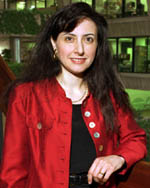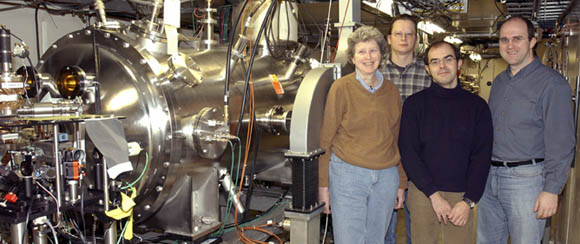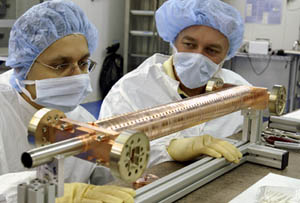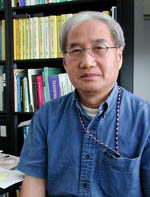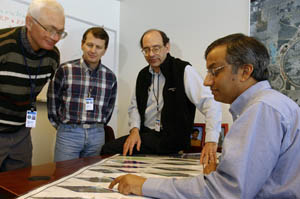 |
|
The
Power of One by Mike Perricone Plans and hopes for a Linear Collider chart a straight course toward unification. Globally, the Linear Collider has united scientific communities in the Americas, Europe and Asia in the vision of an underground high-energy facility some 25-30 miles in length, functioning from the outset as a truly cooperative world laboratory. Its mission: exploring the world of the fundamental particles and forces with unprecedented precision by colliding electrons and positrons at an unmatched energy of one trillion electron volts (1 TeV). Scientifically, the Linear Collider could bring physicists stealing to the borders of the realm of unification—and the Planck Scale, where relative distances are so small, and energies so high, that only quantum gravity could explain behavior there. At the Planck Scale, physicists hope for their first contact with high-energy conditions harking back to the unification of the forces, their first steps on a trail leading back to the common origins of the fundamentally dichotomous quarks and leptons. The Linear Collider will also provide the first experimental understanding of the nature of dark matter, building a unity of cosmology and particle physics.
"For example, in measuring the masses of the superpartners of quarks and leptons," Carena continued, "we can project them back to very high energies and see if they come to a place where they unify. We don't know how they originated, but we suspect it is some kind of Planckian physics. With the linear collider, we will be able to test this Planck scale physics from the lower energy spectrum." In addition, the LC could bring cosmic evidence of dark matter into the realm of direct experimental investigation. Collider physics allows us to produce dark matter in the laboratory and study it under controlled circumstances. "A linear collider is our best opportunity," Carena said. A scientific certainty is the impact of the LC on results from the Large Hadron Collider, being constructed at CERN in Europe. "With its precision, the linear collider will enrich the quality of the LHC results in a crucial way," Carena said. "It will greatly enhance the physics revenue of our investment in the LHC."
"Frontier outpost at the edge of a new world" "High-energy physics has always been a frontier discipline in science, driving technological innovation (the World Wide Web was created to share data from accelerator experiments, for example) and pushing the limits of what we know in the disparate but interconnected worlds of cosmology and elementary particles. The Linear Collider could be considered the high-tech equivalent of a frontier outpost at the edge of a new world." It might have added: "...with the involvement of the entire world."
The International Committee on Future Accelerators (ICFA), founded in 1976, has formed a 12-member International Technology Recommendation Panel (ITRP) to report by the end of 2004 on the path of choice for Linear Collider technology: a "warm" or "cold" design, with the accelerating devices in the main linacs operating at normal temperatures or at superconducting temperatures, respectively. The ITRP comprises representatives from the three major scientific regions: four each from America, Europe and Japan. The American members are Paul Grannis, of the State University of New York at Stony Brook and Fermilab's DZero collaboration; former Fermilab physicist Norbert Holtkamp, now head of the Accelerator Division of the $1.4 billion Spallation Neutron Source at Oak Ridge National Laboratory; Jonathan Bagger of Johns Hopkins University; and the chair, Barry Barish of the California Institute of Technology. Leading the development of cold technology has been DESY, the Deutsches Elektronen-Synchrotron of Hamburg, Germany with its TESLA (Tera electron-volt Energy Superconducting Linear Accelerator) design. Leading the warm (or X-band) technology design have been Stanford Linear Accelerator Center, and the KEK laboratory in Japan, with the Next Linear Collider design. Fermilab is in a unique position, participating in both warm and cold efforts, though the majority of the work is focusing on warm technology in collaboration with SLAC and KEK.
Holmes said certain areas of the LC, such as beam delivery and final focus, or interaction region, "mostly don't care if the machine is warm or cold." While the cold machine would apparently be about 30% longer than the warm machine, issues of selecting a site for the machine are not significantly different for the two technologies. "Looming over all this is the technology decision," Holmes said. "In the interim, the world is pursuing warm and cold technologies in parallel, but with the expectation that the two efforts will be consolidated into a single effort about the end of the year." ICFA hopes to establish an international design center by the time the recommendation is issued.
"Real work is going on here" "Real work is going on here, and a lot of it," he said. "We are concentrating on two major components of the Linear Collider: the linac and the damping ring. The range of topics in accelerator physics is very vast in those areas." Presenting Linear Collider-related research papers would be yet another example of the wide-ranging efforts around the laboratory, centered at the Industrial Complex of the Technical Division. For the warm machine, Fermilab has a radiofrequency structure factory in Industrial Building 4. The lab has produced several versions of prototype high-gradient RF structures for NLC, and has delivered to SLAC the first RF structure fully meeting the NLC requirements for gradient and breakdown rate. In addition, 75% of the RF structures currently in the "8-pack" at SLAC's Next Linear Collider Test Accelerator have been fabricated at Fermilab. SLAC recently completed a highly successful test of the RF power systems (see FERMINEWS, February 2004, "NLC Collaboration Reaches Critical High-Power X-band Goal"). Fermilab is also moving ahead in structural support design, and on adjustable quadrupole magnets to steer the beam. As a TESLA collaborator on the cold technology, Fermilab's Accelerator Division has built the modulators used in the Tesla Test Facility (TTF). The Technical and Accelerator Divisions are collaborating on the design of a superconducting harmonic cavity, an effort led for several years by Helen Edwards. In addition, the Fermilab NICADD Photoinjector Lab (FNPL), operated by Fermilab and Northern Illinois University, is furthering research with superconducting TESLA cavities. Fermilab built two RF guns, the sources of the electron beams; one was used at TTF for several years, Edwards said, and is now being replaced with a new DESY design. Peoples Fellows Philippe Piot and Markus Huening, and DESY postdoc Kai Desler are working at FNPL. Fermilab is also working with nearby Argonne National Laboratory in key areas, drawing on Argonne physicists' experience with the Advanced Photon Source, the nation's premier x-ray synchrotron radiation facility. "The accelerator physicists at APS are the world's leading experts in electron storage rings," said Argonne's Kwang-Je Kim. "We can contribute to the damping ring design. The APS accelerator physicists are very experienced in designing radiation devices, called undulators and wigglers. We are developing super-conducting wigglers that could be important for damping the electron or positron beams because of their powerful radiation properties."
"Argonne's future is closely tied with Fermilab's since we are within a half-hour's driving distance," Kim said. "We would like to work together to strengthen the prospects of hosting a Linear Collider at Fermilab."
"Delicious accelerator challenges" "There wasn't much of a move at previously uninvolved universities to become engaged with the LC effort," said Gollin, who now spends several days each week at the lab. "We looked into it and we found absolutely delicious accelerator challenges out there, very good projects that were very well-suited for university groups. We can do smaller-scale things, like modeling, or working on instrumentation." The damping ring is critical to LC operation, Gollin explained, because the bunches of positrons and electrons moving down the beam line are "hot," not behaving uniformly. "They're little fiery clouds of stuff that you can't really focus well," Gollin said. "Damping rings reduce the 'temperature,' if you want to call it that, of the electrons or positrons. It forces them to travel more like a laser beam, in parallel, so you can focus the beam down very tightly." The damping ring for TESLA loomed as a very long component—some 17 kilometers (10.2 miles) in length. Gollin thought he could shorten the length for the LC, but he couldn't clear the hurdle ("show-stopper," in physics-speak) of having the particles at both the front and back of a bunch experience the same magnetic "kick" to align them. "One of my undergraduates actually solved one of the show-stoppers," Gollin said. "What this student did was solve the mathematical problem of how to select the parameters of the devices inside the kicker, so the experience of a particle at the front of the bunch was the same as the experience of a particle at the back of the bunch. It involved some mathematics that he was just better at than I was. It was delightful to have him solve it." Gollin especially appreciated the chance for undergraduates to contribute to frontier science with basic physics knowledge. "They haven't had quantum mechanics yet, but they've had classical physics, the physics of motion, and classical electrodynamics, the physics of electrical and magnetic fields," Gollin said. "Many of the accelerator challenges involve classical physics. So they have the opportunity to do great things in our lab using the classical physics that we've taught them."
"We want to take the leadership in science for the United States" "We'd really like to get Fermilab physicists and users to be highly involved," he said. "This machine has been recommended as the No. 1 midrange priority for the DOE Office of Science. It's a highly supported project. We should do everything we can to make this machine a reality at Fermilab."
But the enormous visa backlog for foreign scientists and students entering the U.S. looms as a challenge for U.S. (and Fermilab) hopes to host the LC. The international science community views the backlog as effectively limiting international participation and access. For example, if they weren't already here, Mishra (coordinator of the labwide effort and a native of India and Carena (co-author of the Linear Collider segment of the lab's forthcoming long-range planning report, and a native of Argentina) might face enormous and frustrating challenges traveling to and from the lab. Mishra cites the case of Kirti Ranjan, a postdoc from the University of Delhi in India, who has half of his time allocated to working on linear collider efforts. It took six months to get him to Fermilab. Many other scientists have stories of students or colleagues who have been frustrated by similar delays. "I really hope the U.S. government can solve the visa problem," Mishra continued. "One of the discussions about hosting the LC in the U.S. is how the U.S. will allow scientists from other countries—and their families—to come and go freely, so they can work here. We want to take the leadership in science for the U.S., and for that our State Department and Department of Energy must work on a solution to the visa issue." John Marburger, Director of the Office of Science and Technology Policy and science adviser to the President, has often expressed his agreement. He recently told the Council of Presidents of Universities Research Association, Fermilab's operating contractor: "The visa situation is very damaging. There is a deep desire to improve the process and to speed it up." The political issue adds another level of uncertainty to the questions of how, when, where—and whether—the Linear Collider will be built. To scientists, however, uncertainty is familiar ground. "Science is about exploration," Carena said. "If we knew where we were going ahead of time, the journey would not be nearly as exciting as it is."
COVER PHOTO: Project Engineer Harry Carter holds one of the machined slotted disks to be used in the construction of FXC-005 for the NLC RF structures. The disks are made from OFHC copper. In the FXC series of structures, it takes 52 of these disks, each with slightly different internal dimensions, to build each structure. Enough of these disks were ordered to build five FXC structures, or a total of 260 disks, plus approximately 50 spares. The disks are machined by Lavezzi Precision, Inc. located in Glendale Heights, Illinois. On the Web:
ICFA
American Linear Collider Physics Group
Next Linear Collider
GLC Project
TESLA Project |
| last modified 3/7/2004 email Fermilab |
FRLsDFx9eyfrPXgV
